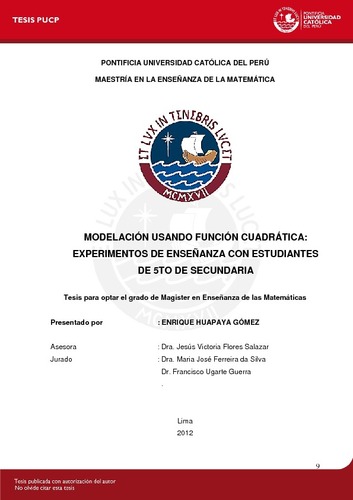| dc.contributor.advisor | Flores Salazar, Jesús Victoria | |
| dc.contributor.author | Huapaya Gómez, Enrique | es_ES |
| dc.date.accessioned | 2012-10-12T15:34:21Z | es_ES |
| dc.date.available | 2012-10-12T15:34:21Z | es_ES |
| dc.date.created | 2012 | es_ES |
| dc.date.issued | 2012-10-12 | es_ES |
| dc.identifier.uri | http://hdl.handle.net/20.500.12404/1571 | |
| dc.description.abstract | Investigaciones en Didáctica de la Matemática sobre el aprendizaje de la función
cuadrática, muestran que estudiantes de secundaria tienen dificultades en el
aprendizaje de este concepto. Nuestra experiencia como docentes corrobora esta
deficiencia, por ello este trabajo presenta una propuesta basada en Experimentos de
Enseñanza, en donde se realizan prácticas de modelación de situaciones problema
apoyadas por el graficador FUNCIONSWIN32 y la hoja de cálculo EXCEL favorece
el aprendizaje de la Función Cuadrática El marco teórico que sustenta nuestra
investigación es la Teoría de los Registros de Representaciones Semióticas (TRRS)
de Duval (2004). Como metodología de investigación, utilizamos el Design
Experiment Cobb (2003). Los resultados obtenidos muestran que efectivamente los
estudiantes realizan prácticas de modelación, apoyados por EXCEL y el graficador
FUNCIONSWIN32, articulando y coordinando los registros de representación de la
función cuadrática, pues sí son capaces de asociar al objeto función cuadrática a
dos o más representaciones durante las prácticas de modelación. | es_ES |
| dc.description.abstract | Research in Mathematics Education on learning of the quadratic function,
show that high school students have difficulty learning this concept. Our
experience as teachers corroborated this deficiency, so this paper presents a
proposal based on experiments of Education, where the practice in modeling
of problem situations FUNCIONSWIN32 supported plotter and Excel
spreadsheet facilitates the learning of the Quadratic Function theoretical
framework underlying our research is the Theory of Semiotics Representations
records (TRRS) Duval (2004). As a research methodology, we use the Cobb
Experiment Design (2003). The results show that students perform effectively
modeling practices, supported by Excel and the graphing FUNCIONSWIN32,
articulating and coordinating records representing the quadratic function
because they are able to associate the quadratic function subject to two or
more performances during the modeling practices. | es_ES |
| dc.language.iso | spa | es_ES |
| dc.publisher | Pontificia Universidad Católica del Perú | es_ES |
| dc.rights | Atribución-CompartirIgual 2.5 Perú | * |
| dc.rights | info:eu-repo/semantics/openAccess | es_ES |
| dc.rights.uri | http://creativecommons.org/licenses/by-sa/2.5/pe/ | * |
| dc.subject | Matemáticas--Estudio y enseñanza (Secundaria). | es_ES |
| dc.title | Modelación usando función cuadrática : experimentos de enseñanza con estudiantes de 5to de secundaria | es_ES |
| dc.type | info:eu-repo/semantics/masterThesis | es_ES |
| thesis.degree.name | Magíster en la enseñanza de las Matemáticas | es_ES |
| thesis.degree.level | Maestría | es_ES |
| thesis.degree.grantor | Pontificia Universidad Católica del Perú. Escuela de Posgrado | es_ES |
| thesis.degree.discipline | Enseñanza de las Matemáticas | es_ES |
| renati.discipline | 199117 | es_ES |
| renati.level | https://purl.org/pe-repo/renati/level#maestro | es_ES |
| renati.type | http://purl.org/pe-repo/renati/type#tesis | es_ES |
| dc.publisher.country | PE | es_ES |
| dc.subject.ocde | https://purl.org/pe-repo/ocde/ford#5.03.01 | es_ES |






